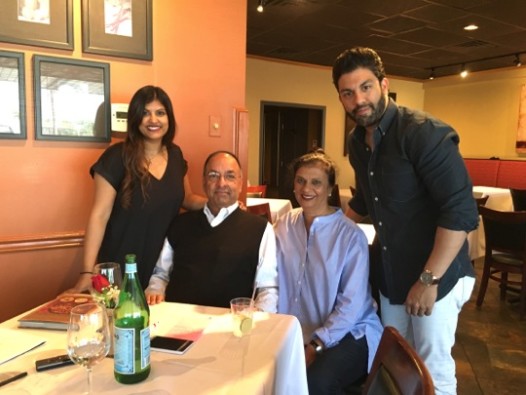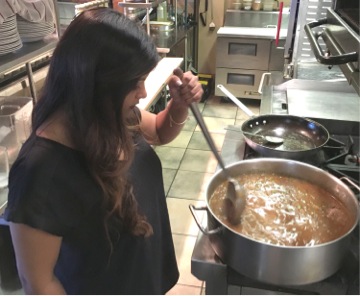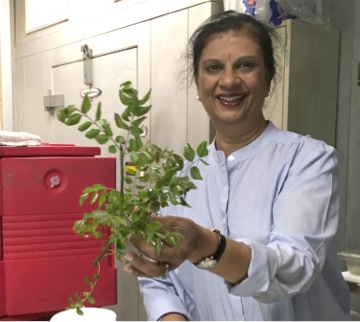
The Vilkhu family keeps the flavors going every Friday night at Saffron in Gretna (Photos: Carol Pulitzer)
The food at Saffron Nola could compete with the best Indian restaurants in New York City or San Francisco; in New Orleans, it has little competition. Don’t go if you’re looking for standard samosas or ubiquitous Tandoori Chicken. At Saffron, local ingredients, traditional Indian techniques, lovely presentations, underpinned by a fine culinary education in Delhi and a photographic memory of cooking learned at grandmother’s knee in Northern India are all reflected on the menu.
Arvinder Vilkhu earned a master’s degree in management at the Hotel School in New Delhi. At a family wedding he met his wife, Pardeep. She was 8; he was 9. Years later, they reconnected and the rest is history. Pardeep was raised in Kenya, 200 miles north of the capital, Nairobi. She, too, hung out with her grandmother and mother in the kitchen and, like Arvinder, always loved to cook. When they immigrated to the United States they could have gone to New York, but New Orleans did that thing it does to some people. They’ve been here nearly 32 years now.
They raised their kids, Ashwin and Pranita, started a catering business, and opened a restaurant, all the while holding day jobs: Arvinder as General Manager of the Pickwick Club for 29 years, and Pardeep as a psychologist for the state of Louisiana, developing programs for individuals with developmental disabilities for 25 years. It seems that the family genes for hard work and success have been passed down to the kids. Ashwin worked nine years in marketing/sales for a wine and spirits company and has just recently joined the family business, managing operations for the restaurant and catering business as well as the beverage program. Pranita serves guests and takes care of whatever needs taking care of while holding down a day job as an auditor at Ochsner. No wonder Saffron is only open as a restaurant on Friday nights! It caters parties and special events as its main bill of fare the rest of time.
On a recent quiet Sunday afternoon, I got a taste of an Indian gumbo that was simmering in the kitchen, and I was sent home with some Dal, a stew of lentils and vegetables, along with a cutting of curry leaf, an ingredient that figures in much of their cooking, sourced from a giant curry tree growing at the Vilkhus’ home.

Pranita stirs a pot of Indian gumbo. (Photos by Carol Pulitzer)
I got educated on the difference between curry as Americans think of it — that yellow spice that comes in a jar — and what is a true Indian curry: any dish that has a gravy. In fact, curry is another word for gravy. The spices are ground at the restaurant and spice combinations vary according to the meat and the region of India from which the dish derives. I learned that instead of making a roux, Indians cook down lots of sliced onions as a base. The darker the meat in the dish, the darker the onions are cooked down. Because they use so many vegetables and spices and only lentil flour when called for, the cuisine is basically gluten free.
Ashwin describes the food at Saffron as familiar/unfamiliar. You know it’s Indian cuisine, but you also know you’re not eating at a curry house. They don’t sacrifice authenticity, but it is Indian food taken up a notch, with beautiful plating, an infusion of local ingredients, and Indian takes on American classics like chicken wings done in a totally Saffron way. Ashwin creates craft cocktails using Indian cuisine and classic cocktails as his inspiration. The one that sounded good to me was the “Indo French Tea Party”: cognac, chai tea, chai tea syrup, fresh lemon, egg whites, topped with champagne, dusted with ground fennel and black tea. The new summer menu will be coming out soon — new drinks, new wines, more cold salads. And it’s mango season!

Pradeep and a curry leaf cutting (Photos by Carol Pulitzer)
Arvinder advised me about spices — always toast them in a dry skillet or oil before grinding. This toasting process brings out the essential oils flavors into the cooking medium. He gave me a health lesson, too, as I learned about turmeric, the latest health darling, which is used in lots of dishes at Saffron.
From Mind, Body, Green: “Epidemiologists have hypothesized that the turmeric that is part of daily curries eaten in India may help explain the low rate of Alzheimer’s disease in that country.”
Turmeric is “an anti-oxidant, an anti-inflammatory, and an anti-septic. Try using turmeric paste on a cut and see how fast it heals and prevents infection as well.” He must believe it, because he takes two turmeric capsules with warm milk or warm water every night before bed. (You can read more about the benefits of turmeric at HealthAmbition.com.)
He is encyclopedic, talking not only about Indian food, but also when discussing its history and geography. I didn’t know that the Brits had divided up the country on their way out after Indian independence. Now when you look at a map of India, you’ll see the tippy top of the country poking up between Eastern Pakistan and Western Pakistan. According to Wikipedia:
“Pakistan was created in 1947 as an independent nation for Muslims from the regions in the east and west of the Subcontinent where there was a Muslim majority. A civil war in 1971 resulted in the secession of East Pakistan as the new country of Bangladesh.”
So one day, what had been Arvinder’s home town became Pakistan overnight. He remembers stories told by his grandmother, who had to trek to safety with only the clothes on her back to return to the new India. This is likely the backstory behind Arvinder’s passionate observation, “You don’t know how good we’ve got it in America.”
I also learned the subtle and not-so-subtle differences in spices that define regional Indian cuisine, as well as some of the forces at work that created those differences. India used to be a confederation of kingdoms, each with its own culture, food, dress, architecture and language. There are 22 major languages in India, written in 13 different scripts, with more than 720 dialects. The official Indian languages are Hindi and English, which is also widely spoken.
The 28 mother tongues of the country derive from ancient Sanskrit. Century after century, India was invaded by men — including, among others, Alexander the Great and Genghis Khan and his Mongol invaders from Northern China, who not only brought terror, but also raisins, nuts, saffron, and stir fry to the cuisine, and the Brits, who introduced tea and chai to the Indian subcontinent.
Just as in Europe, cooks from the cooler climate of the north used more butterfat and animal fats. To the south, they used more coconut oil and vegetable oils. Wheat prevails in the north (naan, rotis, pooris); to the south, rice and coconuts rule (coconut rice, biryani, dosa), and to the east and west coasts, seafood, coconut milk, and mango impact the region’s cuisine.
About 80 percent of Indians are Hindus. Their prohibition from eating meat gave birth to an inventive vegetarian cuisine, literally super-spiced-up to make it interesting and using lentils and beans as protein substitutes for meat.
I go through about a jar a week of the condiments Saffron sells. My favorite is the mixed vegetable pickle; it perks up soups, sandwiches, meat … pretty much anything but dessert. The green cayenne pickle is literally the hottest thing I’ve ever tasted. I think it will last a year or two, because you have to use such a tiny bit. It’s lethal, but be brave. You can buy it at Whole Foods and at the restaurant.
If you get a hankering to cook Indian food at home, ingredients can be bought at International Foods, 3840 Barron St. and 2901 Richland Ave., Metairie, 504.888.8832.
Really understanding Indian cuisine is like really understanding biology or anything else that’s been refined into complexity over hundreds of years. Arvinder tried to explain basic Indian cooking to me, but eventually gave up: “You have to have an Indian grandma to really understand our cuisine.”
Nevertheless, I picked up a few tidbits:
 New Orleans Startups
A brief overview of the growing New Orleans startup scene. This piece highlights the main industries of New Orleans, competing cities, and just how emerging the current entrepreneurial/startup scene is in New Orleans.
New Orleans Startups
A brief overview of the growing New Orleans startup scene. This piece highlights the main industries of New Orleans, competing cities, and just how emerging the current entrepreneurial/startup scene is in New Orleans.
 A Bin in Every Classroom: Why Tulane Should Lead on Composting
I asked a peer, Isabel, for her thoughts on composting: “Why do...
Tulane
A Bin in Every Classroom: Why Tulane Should Lead on Composting
I asked a peer, Isabel, for her thoughts on composting: “Why do...
Tulane
[…] Gem #8: Saffron […]